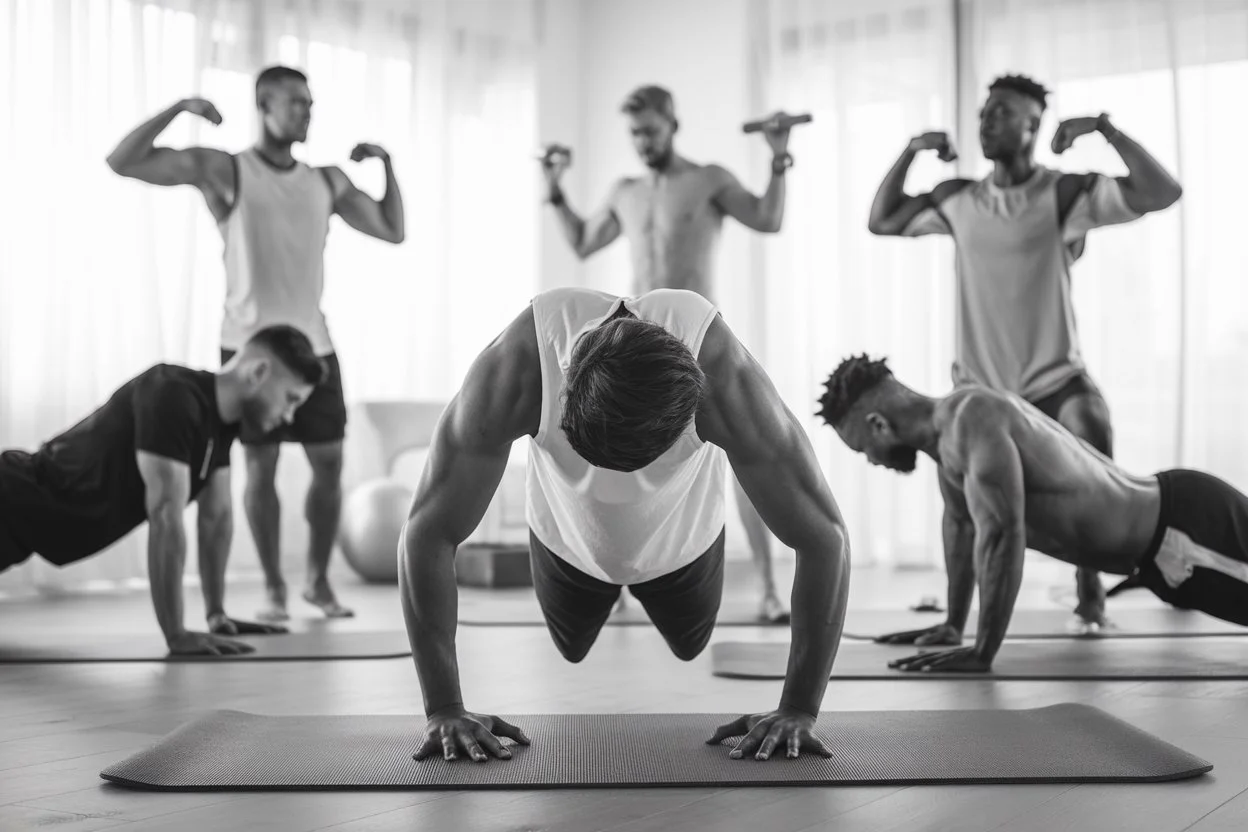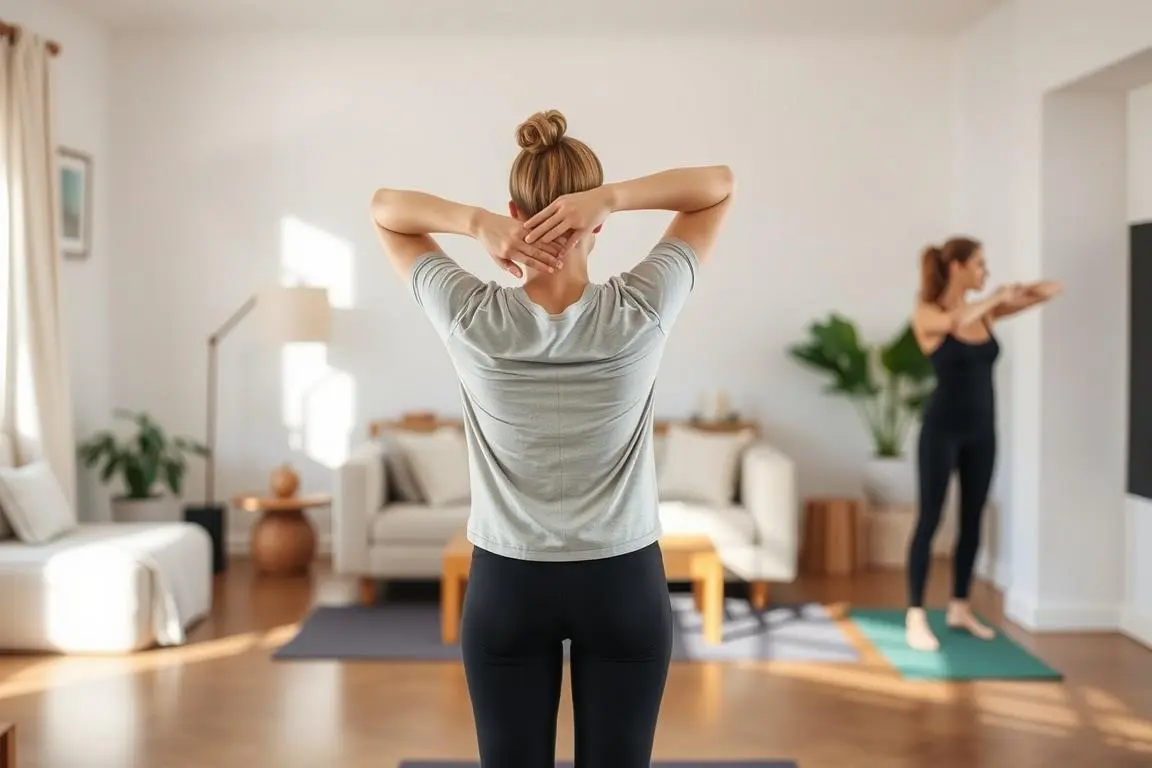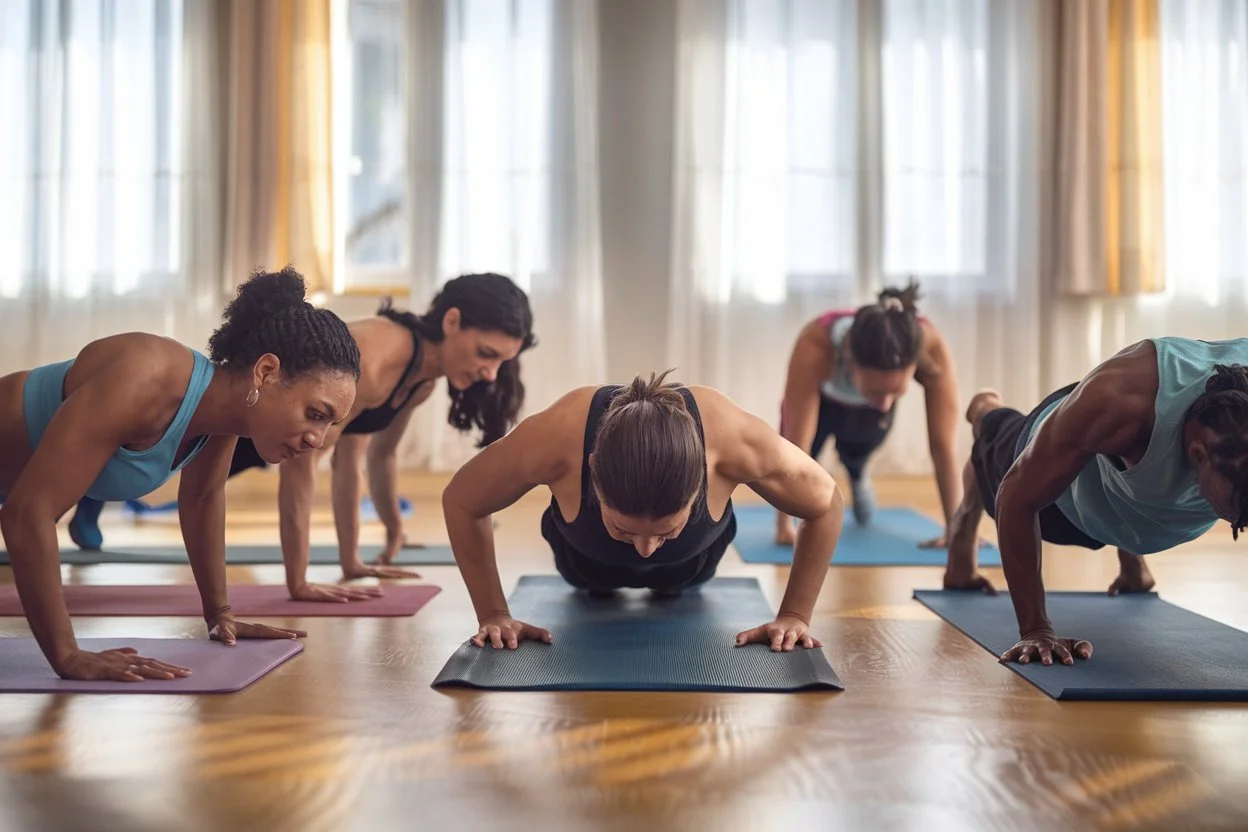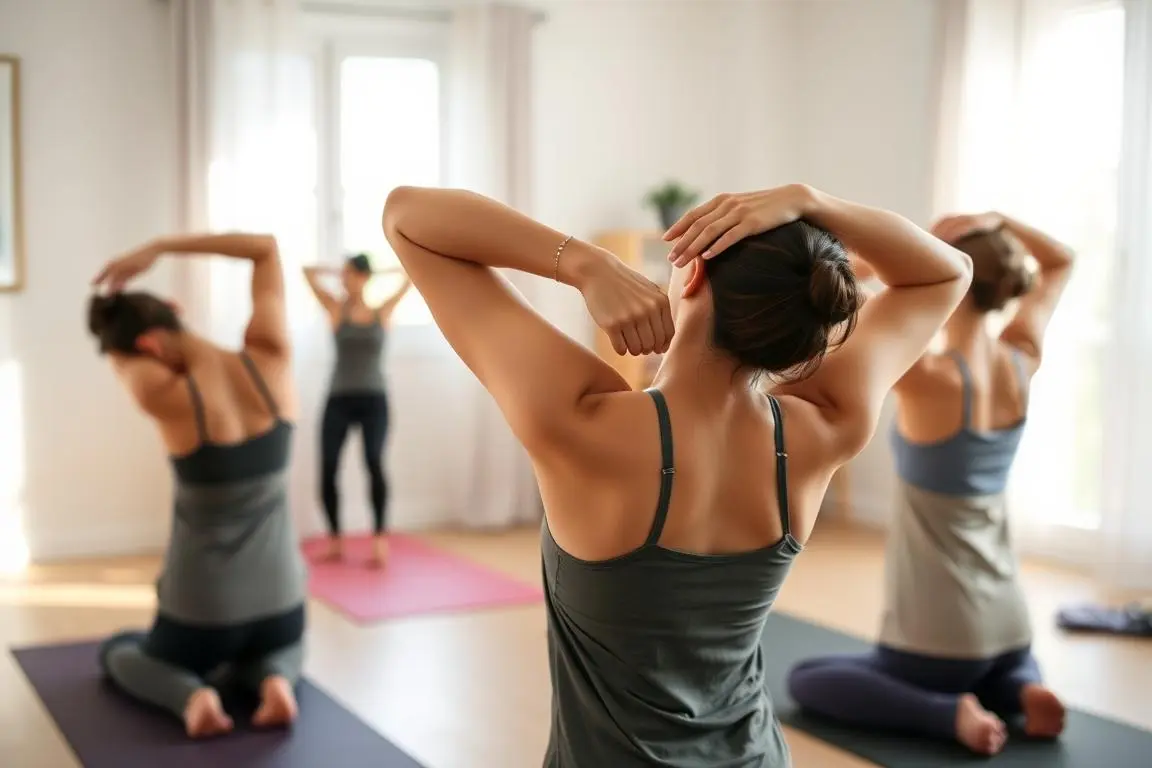5 Simple Bodyweight Shoulder Workouts for Beginners at Home (No Equipment Required)
Did you know that just 10 minutes of bodyweight shoulder exercises a day can boost your upper body strength? You don’t need expensive gym equipment or heavy weights to get strong shoulders. Here, I’ll show you five easy bodyweight shoulder workouts you can do at home.

Key Takeaways
- Bodyweight shoulder exercises are an efficient and accessible way to build upper body strength without equipment.
- These workouts can be done at home, requiring no gym membership or specialty gear.
- Focusing on proper form and technique is crucial to getting the most out of your shoulder exercises.
- Incorporating a variety of shoulder exercises like push-ups, taps, and raises can target different muscle groups.
- Consistency and progressive overload are key to seeing sustainable results from your bodyweight shoulder workouts.
Introduction to Bodyweight Shoulder Training
Bodyweight shoulder exercises are a great way to get stronger and more flexible without any equipment. They work on the deltoids, trapezius, and rotator cuff muscles. By doing them right, you can make your shoulders stronger and safer.
Benefits of Bodyweight Shoulder Exercises
Adding bodyweight shoulder exercises to your workout has many advantages. These include:
- Enhances shoulder stability and strength
- Improves overall shoulder mobility and flexibility
- Helps you stand taller with confidence while protecting your shoulders from injury.
- Can be performed anywhere, making them convenient for shoulder mobility exercises for beginners
- Helps develop best bodyweight shoulder exercises for beginners without the need for weights
Importance of Proper Form and Technique
When doing how to strengthen shoulders without weights, form is key. Doing the shoulder workout without weights right helps you get the most out of them and keeps you safe. It’s important to move slowly, keep your core tight, and stay aligned.
Knowing the benefits of bodyweight shoulder exercises and focusing on form lets you get the most out of them. These exercises are powerful and effective for strengthening your shoulders.
Beginner Shoulder Warm-up Exercises
Before starting your shoulder mobility exercises for beginners and home shoulder workout for beginners no weights, warm up your shoulders. This step boosts blood flow, improves mobility, and lowers injury risk. Here are some easy shoulder warm-up exercises to get you ready for your workout.
Shoulder Circles
Stand tall with your feet aligned under your shoulders and your arms relaxed at your sides. Make small circles with your shoulders, first forward and then backward. Do 10-15 circles in each direction.
Arm Swings
- Stand strong with your feet hip-width apart, letting your arms hang naturally by your sides, ready to move.
- Swing your arms forward and backward, keeping them straight and slightly bent at the elbows.
- Do this for 10-15 swings.
Shoulder Taps
- Stand with your feet shoulder-width apart and your arms at your sides.
- Raise your right arm and tap your left shoulder, then switch and tap your right shoulder with your left arm.
- Keep alternating for 10-15 reps.
These exercises are great for getting your body ready for shoulder mobility exercises for beginners and home shoulder workout for beginners no weights. Stay mindful of your form and technique—it’s the key to unlocking the full benefits of these warm-ups.

Shoulder Taps
Shoulder taps are a great bodyweight exercise for strengthening your shoulder muscles. You don’t need any equipment to do it. This exercise targets the deltoids, improving your shoulder mobility and upper body strength.
Step-by-Step Instructions
- Begin in a strong high plank, with your hands placed just beneath your shoulders, keeping your body in a straight, powerful line from your head all the way to your heels.
- Lift your right hand and tap the top of your left shoulder, then return your hand to the starting position.
- Repeat the same motion with your left hand, tapping the top of your right shoulder.
- Continue alternating between right and left shoulder taps, maintaining a stable core and proper plank form throughout the exercise.
Variations and Progressions
Once you get the hang of shoulder taps, try these variations to boost your shoulder strength and stability:
- Elevated Shoulder Taps: Elevate your feet on a bench or step to increase the resistance and engage your shoulders even more.
- Staggered Shoulder Taps: Instead of tapping the shoulder directly above your hand, try tapping the shoulder that is diagonally opposite (e.g., tap your left shoulder with your right hand).
- Single-Arm Shoulder Taps: Perform the exercise with one arm at a time, keeping the other hand on the ground for support.
Always keep proper form to get the most out of the exercise and avoid injury. Start with a number of reps you can handle and increase it as you get stronger.
Push-up Variations for Shoulder Strength
Bodyweight exercises like push-ups are great for building shoulder strength. Two effective variations are wide-arm push-ups and decline push-ups. They are perfect for beginners who want to do bodyweight upper body workout and effective shoulder exercises without equipment at home.
Wide-Arm Push-ups
Start in a push-up position with your hands wider than shoulder-width apart for wide-arm push-ups. Lower your body, focusing on your shoulder muscles. Pause at the bottom, then push back up.
This variation works your shoulder deltoids more than a regular push-up.
Decline Push-ups
For decline push-ups, place your feet on a bench or step. This makes your shoulders work harder. Keep your body straight as you lower your chest, then push back up.
Decline push-ups are a tough home shoulder workouts no weights option for extra challenge.
Adding these push-up variations to your bodyweight upper body workout routine can strengthen your shoulders. Always focus on proper form to avoid injury.

Bodyweight Workout for Shoulder Mobility
Improving shoulder mobility is key for good shoulder health and performance. This section offers a bodyweight workout to boost shoulder mobility exercises for beginners. The exercises in this home shoulder workout for beginners no weights will enhance your range of motion. They also lower injury risk and improve your ability to do other shoulder exercises right.
Adding these shoulder mobility exercises to your home shoulder workout for beginners no weights can greatly improve your shoulder function and health. Let’s explore the exercises that will enhance your shoulder mobility. They will also get your body ready for more advanced shoulder workouts.
- Shoulder Circles: Stand with your feet shoulder-width apart, engage your core, and make large circular motions with your shoulders, rotating them forward and backward.
- Arm Swings: Swing your arms across your body, alternating between forward and backward motions, keeping your core engaged and maintaining good posture.
- Wall Slides: Stand facing a wall, with your heels a few inches away from the wall. Raise your arms overhead, keeping them in contact with the wall, and slowly slide them down the wall and back up.
“Improving shoulder mobility is a game-changer for your overall shoulder health and performance. Incorporate these exercises into your routine, and you’ll notice a significant difference in your range of motion and ability to perform other shoulder-focused exercises.”
Remember, consistent practice and proper form are crucial for these shoulder mobility exercises for beginners. Add this home shoulder workout for beginners no weights to your routine. You’ll see a big improvement in your shoulder mobility and overall health.

Wall Shoulder Taps
Discover the power of bodyweight shoulder exercises with wall shoulder taps. This exercise works your shoulder muscles and improves balance and stability. It’s a great choice for your simple upper body exercises at home routine.
To do the wall shoulder taps, follow these steps:
- Stand facing a wall, with your feet shoulder-width apart and your palms flat against the wall at shoulder height.
- Engage your core and keep a straight line from your head to your heels.
- Lift one hand off the wall, reaching across your body to tap the opposite shoulder.
- Put your hand back where it started, then do the same with the other hand.
- Keep switching hands, staying in control and stable.
For more of a challenge, try wall shoulder taps with one leg raised or in a staggered stance. As you get better, increase the movement range or speed. This keeps your body and muscles engaged.
“The wall shoulder tap is a fantastic bodyweight exercise that targets the shoulder muscles while also improving your balance and stability. It’s a must-have in any bodyweight shoulder exercises routine.”
Add wall shoulder taps to your simple upper body exercises at home routine. Regular practice and proper form will strengthen your shoulders. You’ll also see better overall upper body strength.
Bodyweight Shoulder Raises
Bodyweight shoulder raises are great for building shoulder strength without equipment. They target the deltoids, which are key for shoulder mobility and upper body power. Let’s look at two effective shoulder raise variations for your home workout.
Front Raise
The front raise is a simple yet effective exercise for the front deltoids. Stand with your feet shoulder-width apart and engage your core. Raise your arms straight out in front, palms down, until they’re parallel to the ground. Slowly lower them back down, keeping control.
To make it harder, hold a light object like a water bottle in each hand.
Lateral Raise
The lateral raise targets the side deltoids, helping to widen and define your shoulders. Stand the same way as for the front raise. Raise your arms out to the sides until they’re parallel to the ground. Slowly lower them back down, keeping your elbows high.
Like the front raise, adding a light weight can increase the challenge.
Add these bodyweight shoulder raises to your home workout to build strength and improve shoulder health. Always focus on proper form to avoid injury and get the most out of these exercises.
For a successful bodyweight shoulder workout, focus on proper form and progressive overload. Start with a manageable number of reps and increase the challenge as you get stronger. Combining these exercises with a well-rounded bodyweight routine can help you reach your fitness goals without extra equipment.
Integrated Bodyweight Shoulder Circuits
To get the most out of your bodyweight workouts, add integrated circuits that focus on your shoulders. These circuits boost your upper body strength, enhance shoulder mobility, and raise your heart rate. They offer a full bodyweight upper body workout.
Here’s a circuit you can try:
- Push-up Shoulder Taps: Begin in a push-up stance. Reach your left hand up to tap your right shoulder, then switch, tapping your left shoulder with your right hand. Keep moving at your own pace, feeling the burn with every rep
- Wall Shoulder Taps: Stand tall in front of a wall, and place your hands firmly at shoulder height, ready to feel the stretch. Tap your right shoulder with your left hand, then your left shoulder with your right hand. Keep going.
- Bodyweight Shoulder Raises: Do front and lateral raises. This works your shoulder muscles fully.
By mixing these home shoulder workouts no weights in a circuit, you’ll strengthen your shoulders. You’ll also boost your upper body strength and heart rate. Always focus on correct form to get the most benefits and avoid injuries.
| Exercise | Sets | Reps |
|---|---|---|
| Push-up Shoulder Taps | 3 | 10-15 |
| Wall Shoulder Taps | 3 | 10-15 |
| Bodyweight Shoulder Raises | 3 | 10-15 each |
Do this bodyweight workouts circuit a few times a week. It’s a great way to work your shoulders and upper body at home without any equipment.
Bodyweight Workout for Shoulder Endurance
Building shoulder endurance is as important as getting stronger. Doing exercises that test your shoulders over time boosts your muscle stamina. This is key for sports, daily tasks, and staying healthy. This bodyweight workout helps you build shoulder endurance without needing any equipment.
The secret to this workout is to keep your movements steady and controlled. Always keep your shoulders active during the exercises. Focus on doing the exercises right to get the most benefits and avoid injuries. Here are some exercises to boost your shoulder endurance at home:
- Wall Shoulder Taps: Stand facing a wall, place your palms on the wall at shoulder height, and tap your right hand to your left shoulder, then your left hand to your right shoulder. Repeat this for 30 seconds to 1 minute, keeping your core engaged and your body in a straight line.
- Bodyweight Shoulder Raises: Stand with your feet shoulder-width apart, arms at your sides. Lift your arms out to the sides, keeping them strong and straight, until they’re perfectly parallel to the floor. Lower them back down with control. Repeat for 10-15 reps.
- Plank Shoulder Taps: Start in a high plank position, keeping your core braced. Lift your right hand and tap your left shoulder, then switch sides. Alternate for 30 seconds to 1 minute, maintaining a straight line from your head to your heels.
Do this bodyweight shoulder endurance workout 2-3 times a week for the best results. Pay attention to your body, and don’t hesitate to take a break when you need to—it’s okay to slow down and recharge. As you get stronger, slowly increase how long and hard you work out. Regular practice will make you more confident in tackling any task or activity.
“Shoulder endurance is the unsung hero of upper-body strength. Develop it, and you’ll unlock a new level of everyday functionality and athletic performance.”
Tips for Progressing Your Bodyweight Shoulder Workouts
As you get better at the bodyweight workouts in this guide, it’s key to know how to make your shoulder exercises harder. Follow these tips to keep pushing your shoulders and see better strength and mobility. You won’t need weights to do it.
- Increase Reps and Sets: Start by slowly adding more repetitions and sets for each exercise. This will help you build muscle endurance in your shoulders.
- Adjust Leverage: Change the way you do the exercises by adjusting your body position or where you touch the ground. Try decline push-ups or elevated push-ups to make it harder.
- Incorporate Advanced Variations: Once you’ve mastered the basics, try harder versions like single-arm push-ups or plyometric push-ups. These will keep your shoulders challenged.
- Focus on Tempo: Slow down how fast you do the movements. Focus on controlled, slow contractions and extensions. This will help build strength and stability in your shoulders.
- Add Instability: Do exercises on unstable surfaces like a BOSU ball or a stability ball. This will work your shoulder stabilizers and improve control.
The secret to improving your no equipment shoulder workout routine for home is to slowly make it harder while keeping your form right. By using these strategies, you can keep strengthening your shoulders without weights and reach your fitness goals.
Conclusion and Recap
As we finish this guide on bodyweight shoulder exercises, let’s talk about their amazing benefits. These simple, no-equipment workouts can make your shoulders stronger and more flexible. They also boost your overall upper body strength and movement.
We’ve looked at many shoulder workout no equipment options in this article. We covered warm-ups, specific shoulder raises, and full-body circuits. It’s key to learn the right form and technique to get the most out of these bodyweight upper body workout routines and avoid injuries.
By doing these bodyweight shoulder exercises regularly at home, you’ll get closer to your fitness goals. You’ll unlock your upper body’s full strength potential. So, why wait? Start these easy yet effective shoulder workouts today and see the change for yourself!
FAQ
What are the benefits of bodyweight shoulder exercises?
‘At home shoulder workout no weights’ are great for building strength and improving mobility. They work on the deltoids, trapezius, and rotator cuff. By focusing on form, you can strengthen your shoulders and avoid injuries.
Why is proper form and technique important for bodyweight shoulder exercises?
Proper form is key for bodyweight shoulder exercises. It helps target the right muscles and avoids injuries. Mastering the right technique means you’re not just working hard, but you’re also protecting yourself and getting the most from every move.
What are some beginner-friendly shoulder warm-up exercises?
Start with shoulder rolls, arm circles, and shoulder taps for a warm-up. These exercises boost blood flow and prepare your body for the workout.
How do I perform shoulder taps with proper form?
Shoulder taps target the shoulder muscles. Start in a high plank, tap your right hand to your left shoulder, then the left to the right. Keep your body straight throughout.
What push-up variations can target the shoulder muscles?
Wide-arm push-ups and decline push-ups are great for shoulders. Wide-arm push-ups work the stabilizers, while decline push-ups focus on the anterior deltoids.
How can I improve my shoulder mobility with bodyweight exercises?
Focus on exercises like arm circles, shoulder dislocates, and wall shoulder taps. They increase mobility, reduce injury risk, and enhance performance.
How do I perform wall shoulder taps?
Stand facing a wall, feet apart, and lift one hand to tap the opposite shoulder. Keep your arm straight. Alternate sides.
What are some effective bodyweight shoulder raise exercises?
Shoulder raises, like front and lateral raises, target the deltoids. Stand with arms at your sides, then raise them straight out in front or to the sides.
How can I incorporate bodyweight shoulder exercises into a circuit-style workout?
Mix exercises like shoulder taps, push-ups, raises, and wall taps in a circuit. This challenges your muscles, boosts strength, and raises your heart rate.
How can I build shoulder endurance with bodyweight exercises?
Include exercises like front raises, lateral raises, and shoulder taps for longer periods or more reps. This builds stamina for sports and daily tasks.
How can I progress my bodyweight shoulder workouts over time?
Increase difficulty by adding reps, adjusting leverage, or trying advanced variations. This keeps challenging your shoulders and promotes growth.

